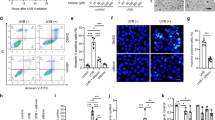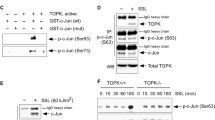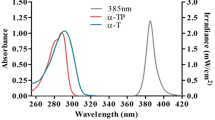Abstract
Multiple exposures to solar ultraviolet (UV) radiation cause critical damages that may lead to the development of several cutaneous disorders including skin cancer, the most frequently diagnosed malignancy in the USA. Therefore, efforts are needed to: (i) study the mechanism(s) of UV-mediated cutaneous damages, and (ii) design novel approaches for the management of skin cancer. ‘Chemoprevention’ via plant-based agents may be a useful approach for the management of neoplasia. Here, we evaluated the involvement of cell cycle regulatory molecules during resveratrol-mediated protection from multiple exposures of UVB (180 mJ/cm2; on alternate days × 7 exposures) radiations in the SKH-1 hairless mouse skin. Resveratrol was topically applied on the skin of SKH-1 hairless mice at a dose of 10 μmol/mouse (in 0.2 ml acetone; 30 min prior to each UVB exposure). Studies were performed at 24 h following the last UVB exposure. Topical application of resveratrol resulted in significant decrease in UVB-induced bi-fold skin thickness, hyperplasia, and infiltration of leukocytes. The data from immunoblot and/or immunohistochemical analyses revealed that multiple exposure to UVB radiations causes significant upregulation in: (i) proliferating cell nuclear antigen (PCNA), a marker of cellular proliferation, and (ii) cyclin-dependent kinase (cdk)-2, -4 and -6, cyclin-D1, and cyclin-D2. Resveratrol treatment resulted in significant downregulation in UV-mediated increases in these critical cell cycle regulatory proteins. An interesting observation of this study was that resveratrol treatment resulted in a further stimulation of UVB-mediated increases in cyclin kinase inhibitor WAF1/p21 and tumor suppressor p53. Further, resveratrol was also found to cause significant decreases in UVB-mediated upregulation of: (i) the mitogen-activated protein kinase kinase, and (ii) the 42 kDa isotype of mitogen-activated protein kinase (MAPK). Thus, our data suggested that the antiproliferative effects of resveratrol might be mediated via modulation in the expression and function of cell cycle regulatory proteins cyclin-D1 and -D2, cdk-2, -4 and -6, and WAF1/p21. Our data further suggest that the modulation of cki–cyclin–cdk network by resveratrol may be associated with inhibition of the MAPK pathway. We suggest that resveratrol may be useful for the prevention of UVB-mediated cutaneous damages including skin cancer.
This is a preview of subscription content, access via your institution
Access options
Subscribe to this journal
Receive 50 print issues and online access
$259.00 per year
only $5.18 per issue
Buy this article
- Purchase on Springer Link
- Instant access to full article PDF
Prices may be subject to local taxes which are calculated during checkout









Similar content being viewed by others
References
Abrieu A, Fisher D, Simon MN, Doree M and Picard A . (1997). EMBO J., 16, 6407–6413.
Adhami VM, Afaq F and Ahmad N . (2001). Biochem. Biophys. Res. Commun., 288, 579–585.
Adhami VM, Afaq F and Ahmad N . (2003). Neoplasia, 5, 74–82.
Afaq F, Adhami VM and Ahmad N . (2003a). Toxicol. Appl. Pharmacol., 186, 28–37.
Afaq F, Adhami VM, Ahmad N and Mukhtar H . (2002). Front. Biosci., 7, d784–d792.
Afaq F, Ahmad N and Mukhtar H . (2003b). Oncogene, 22, 9254–9264.
Ahmad N, Adhami VM, Afaq F, Feyes DK and Mukhtar H . (2001). Clin. Cancer Res., 7, 1466–1473.
Ahmad N and Mukhtar H . (2001). Skin Pharmacol. Appl. Skin Physiol., 14, 69–76.
Ahmed NU, Ueda M and Ichihashi M . (1999). J. Dermatol. Sci., 19, 175–181.
Bickers DR and Athar M . (2000). J. Dermatol., 27, 691–695.
Black HS, deGruijl FR, Forbes PD, Cleaver JE, Ananthaswamy HN, deFabo EC, Ullrich SE and Tyrrell RM . (1997). J. Photochem. Photobiol. B, 40, 29–47.
Bowden GT . (2004). Nat. Rev. Cancer, 4, 23–35.
Brugarolas J, Chandrasekaran C, Gordon JI, Beach D, Jacks T and Hannon GJ . (1995). Nature, 377, 552–557.
Chen W and Bowden GT . (1999). Oncogene, 18, 7469–7476.
Chen W, Tang Q, Gonzales MS and Bowden GT . (2001). Oncogene, 20, 3921–3926.
de Gruijl FR . (2002). Skin Pharmacol. Appl. Skin Physiol., 15, 316–320.
Dreher F and Maibach H . (2001). Curr. Probl. Dermatol., 29, 157–164.
Eckert RL, Efimova T, Dashti SR, Balasubramanian S, Deucher A, Crish JF, Sturniolo M and Bone F . (2002). J. Investig. Dermatol. Symp. Proc., 7, 36–40.
Einspahr JG, Bowden GT and Alberts DS . (2003). Recent Results Cancer Res., 163, 151–164.
F’guyer S, Afaq F and Mukhtar H . (2003). Photodermatol. Photoimmunol. Photomed., 19, 56–72.
Gillitzer R and Goebeler M . (2001). J. Leukoc. Biol., 69, 513–521.
Hatoko M, Tanaka A, Kuwahara M and Yurugi S . (2001). Ann. Plast. Surg., 47, 425–430.
Katiyar SK, Afaq F, Azizuddin K and Mukhtar H . (2001). Toxicol. Appl. Pharmacol., 176, 10–17.
Katiyar SK, Challa A, McCormick TS, Cooper KD and Mukhtar H . (1999). Carcinogenesis, 20, 2117–2124.
Katiyar SK, Korman NJ, Mukhtar H and Agarwal R . (1997). J. Natl. Cancer Inst., 89, 556–566.
Katiyar SK and Mukhtar H . (2001). J. Leukoc. Biol., 69, 719–726.
Kim AL, Athar M, Bickers DR and Gautier J . (2002). Photochem. Photobiol., 75, 58–67.
Kulms D and Schwarz TJ . (2002). Dermatology, 29, 189–196.
Lu YP, Lou YR, Li XH, Xie JG, Brash D, Huang MT and Conney AH . (2000). Cancer Res., 60, 4785–4791.
Lu YP, Lou YR, Yen P, Mitchell D, Huang MT and Conney AH . (1999). Cancer Res., 59, 4591–4602.
Murphy M, Mabruk MJ, Lenane P, Liew A, McCann P, Buckley A, Flatharta CO, Hevey D, Billet P, Robertson W, Javed S, Leader M, Kay E and Murphy GM . (2002). J. Clin. Pathol., 55, 829–833.
Naylor MF . (1997). Arch. Dermatol., 133, 373–375.
Petrocelli T, Poon R, Drucker D J, Slingerland JM and Rosen CF . (1996). Oncogene, 12, 1387–1396.
Petrocelli T and Slingerland J . (2000). Oncogene, 19, 4480–4490.
Robles AI, Rodriguez-Puebla ML, Glick AB, Trempus C, Hansen L, Sicinski P, Tennant RW, Weinberg RA, Yuspa SH and Conti CJ . (1998). Genes Dev., 12, 2469–2474.
Sander CS, Hamm F, Elsner P and Thiele JJ . (2003). Br. J. Dermatol., 148, 913–922.
Scharffetter-Kochanek K, Wlaschek M, Brenneisen P, Schauen M, Blaudschun R and Wenk J . (1997). Biol. Chem., 378, 1247–1257.
Terada Y, Inoshita S, Nakashima O, Kuwahara M, Sasaki S and Marumo F . (1999a). Kidney Int., 56, 1258–1261.
Terada Y, Nakashima O, Inoshita S, Kuwahara M, Sasaki S and Marumo F . (1999b). Kidney Int., 56, 1378–1390.
Tyrrell RM . (1996). BioEssays, 18, 139–148.
Wang W, Rastinejad F and El-Deiry WS . (2003). Cancer Biol. Ther., 2, S55–S63.
Yamamoto H, Ochiya T, Takeshita F, Toriyama-Baba H, Hirai K, Sasaki H, Sasaki H, Sakamoto H, Yoshida T, Saito I and Terada M . (2002). Cancer Res., 62, 1641–1647.
Yano S, Komine M, Fujimoto M, Okochi H and Tamaki K . (2003). Biochem. Biophys. Res. Commun., 301, 841–847.
Acknowledgements
This work was supported by funding from the United States Public Health Services (Grants # RO3 CA 98368 and RO3 CA 99076) and ELSA U Pardee Foundation.
Author information
Authors and Affiliations
Corresponding author
Rights and permissions
About this article
Cite this article
Reagan-Shaw, S., Afaq, F., Aziz, M. et al. Modulations of critical cell cycle regulatory events during chemoprevention of ultraviolet B-mediated responses by resveratrol in SKH-1 hairless mouse skin. Oncogene 23, 5151–5160 (2004). https://doi.org/10.1038/sj.onc.1207666
Received:
Revised:
Accepted:
Published:
Issue Date:
DOI: https://doi.org/10.1038/sj.onc.1207666
Keywords
This article is cited by
-
Dietary compounds and cutaneous malignant melanoma: recent advances from a biological perspective
Nutrition & Metabolism (2019)
-
Anticancer effect and enhanced chemotherapy potential of resveratrol in human pancreatic cancer cell lines ⁎
Oncology and Translational Medicine (2016)
-
Use of Polyphenolic Compounds in Dermatologic Oncology
American Journal of Clinical Dermatology (2016)
-
Resveratrol: a supplementation for men or for mice?
Journal of Translational Medicine (2014)



